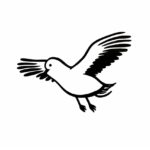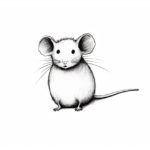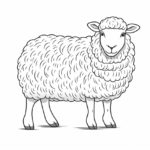Scorpions are fascinating creatures known for their unique appearance and venomous sting. Drawing a scorpion can be a fun and rewarding artistic challenge. In this step-by-step guide, I will walk you through the process of how to draw a scorpion in a clear and concise manner. Whether you are a beginner or an experienced artist, you will find these instructions helpful in creating a realistic and detailed scorpion drawing.
Materials Required
Before we begin, gather the following materials:
- Drawing paper or sketch pad
- Pencils (HB, 2B, and 4B)
- Eraser
- Fine-tip black pen or marker
- Reference image of a scorpion (optional but recommended)
Having these materials at hand will ensure a smooth and enjoyable drawing experience.
Step 1: Basic Guidelines
To start, lightly sketch the basic guidelines for your scorpion drawing. Begin by drawing a large oval shape for the body and a smaller oval shape for the head. Then, draw a long, curved line extending from the body for the tail. Add two smaller ovals at the front of the head for the pincers.
Step 2: Body and Tail
Using the basic guidelines, start adding more detail to your scorpion drawing. Begin with the body by drawing a smooth, curved line following the shape of the oval. Add segments to the body by drawing shorter, curved lines across its length. Next, draw the tail by following the initial guideline and adding more segments to it. Scorpions have a distinct stinger at the tip of their tails, so make sure to include that as well.
Step 3: Pincers
Moving on to the pincers, begin by adding more definition to the ovals by drawing the upper and lower parts of each pincer. Scorpions have sharp and curved pincers, so pay attention to their shape and proportions. Add smaller details, such as joints and ridges, to make the pincers look more realistic.
Step 4: Legs
Now, let’s draw the legs of the scorpion. Start by sketching the first pair of legs on each side of the body. Each leg consists of several segments, so make sure to draw them accordingly. Follow the same process for the remaining three pairs of legs. Take your time to ensure that the proportions and angles of the legs are accurate.
Step 5: Details
Now that the basic structure of the scorpion is complete, it’s time to add more details. Study your reference image or use your imagination to draw the eyes, mouthparts, and other small features of the scorpion’s head. You can also add texture and shading to the body and tail to give your drawing more depth and realism. Use a darker pencil (such as 4B) to create shadows and define the contours.
Step 6: Finalize
In this final step, refine your scorpion drawing by erasing any unnecessary guidelines and smudges. Use a fine-tip black pen or marker to outline the main features of the scorpion and define the details. Take your time and work carefully to achieve clean and precise lines. If you wish, you can also add additional details or patterns to make your scorpion drawing unique.
Conclusion
Drawing a scorpion may seem challenging at first, but with the right guidance and practice, you can create a stunning artwork. By following the step-by-step instructions provided in this article, you can develop your skills and create a realistic and detailed scorpion drawing. Remember to be patient, pay attention to details, and most importantly, have fun with your artwork. Happy drawing!
Fun Facts About Scorpions
- Scorpions are ancient creatures, with fossils dating back over 430 million years, placing them among the oldest known terrestrial animals.
- There are approximately 2,000 known species of scorpions worldwide, varying greatly in size and color.
- Scorpions glow under ultraviolet light due to substances found in their exoskeleton, making them easier to spot at night with a UV torch.
- Despite their fearsome reputation, only about 25 species of scorpions have venom potent enough to be dangerous to humans.
- Scorpions can survive without food for up to a year, showcasing their remarkable adaptation abilities in harsh environments.
- Their pincers, or pedipalps, are used for capturing prey and as a way to defend themselves from threats.
- Scorpions have a unique feature called a pectine, a comb-like sensory organ that helps them detect and navigate their environment.
- In ancient mythology and astrology, scorpions have been associated with protection, strength, and the power of transformation.
- Scorpions give birth to live young, which they carry on their back until they have undergone at least one molt.
- Scorpions live on every continent except Antarctica, preferring deserts and tropical environments but are adaptable to a range of habitats.
Suggestions for Scenes and Settings for Scorpion Drawings
- Desert Dunes: Draw scorpions navigating rolling desert dunes under a moonlit sky with stars twinkling above.
- Ancient Ruins: Illustrate scorpions exploring crumbling ruins, their pincers casting long shadows across stone carvings.
- Jungle Floor: Capture scorpions nestled among vibrant jungle foliage, with a cascade of sunlight filtering through the canopy.
- Cave Adventure: Depict scorpions exploring the depths of a cave, stalactites hanging overhead and mysterious cave paintings on the walls.
- Scorpions Under UV Light: Show a scene where scorpions glow under a dramatic ultraviolet light, highlighting their eerie, alien-like forms.
- Mythological Tale: Create a narrative scene where scorpions interact with ancient gods or symbols, embodying tales of the past.
- Phoenix Encounter: Illustrate scorpions facing a majestic phoenix, feathers bright with flames, forming a balance between fire and earth.
- Futuristic Habitat: Design a sci-fi setting where scorpions survive in a futuristic terrarium with advanced technology monitoring their habitat.
- Mini Scorpion City: Imagine a tiny city created by and for scorpions, complete with little streets, tunnels, and buildings.
- Seasonal Transformation: Draw scorpions in different seasons, from the blazing heat of summer to the icy calm of winter, showcasing their adaptability.








